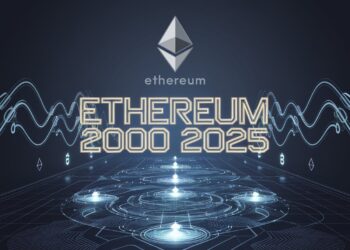Imagine a bustling digital metropolis, its streets clogged with transactions, its citizens clamoring for faster, cheaper ways to move value. This is Ethereum today—a titan of the blockchain world grappling with its own success. At the Digital Asset Summit in New York on March 22, 2025, Ethereum co-founder Joe Lubin stepped into the spotlight, not to deflect criticism, but to double down on a vision that could redefine the network’s future: Layer 2 solutions.
Ethereum’s Layer 2 Revolution Unveiled
Ethereum has long been the backbone of decentralized innovation, hosting everything from NFTs to DeFi protocols. Yet, its growth has come at a cost—network congestion and soaring fees that frustrate users and developers alike. Lubin’s appearance at the summit wasn’t just a defense; it was a bold declaration that Ethereum’s evolution is far from over.
Why Layer 2 Matters Now
The Ethereum network, while secure and robust, faces a scalability bottleneck. Its main chain can’t handle the sheer volume of transactions demanded by today’s decentralized applications. Lubin argues that Layer 2 solutions—networks built atop Ethereum—are the key to unlocking this gridlock without sacrificing security.
These secondary layers process transactions off-chain or in a more efficient manner, then settle them on Ethereum’s main ledger. The result? Faster speeds, lower costs, and a network that can scale to meet global demand. Lubin sees this as more than a technical fix—it’s a strategic move to keep Ethereum ahead of rival blockchains.
Decentralized apps need high-throughput databases, and that’s what Layer 2 delivers for Ethereum.
– Joe Lubin, Ethereum Co-Founder
The Critics Speak: Is Ethereum Losing Ground?
Not everyone shares Lubin’s optimism. Critics point to Ethereum’s sluggish transaction speeds and the underwhelming price performance of its native cryptocurrency, ETH, as signs of trouble. Newer Layer 1 blockchains—touted as “Ethereum killers”—promise faster, cheaper alternatives, luring developers and investors away.
Then there’s the complexity of Ethereum’s ongoing upgrades, like the Pectra update, which some argue muddies the waters for users. Add in the proliferation of Layer 2s, and you’ve got a recipe for confusion—could this fragmentation dilute Ethereum’s core strength? Lubin, however, remains unfazed.
Linea and MegaETH: The Stars of Layer 2
During his interview, Lubin spotlighted two standout Layer 2 projects: Linea and MegaETH. Linea, developed by ConsenSys (where Lubin serves as CEO), is a zero-knowledge rollup designed to boost transaction efficiency while preserving Ethereum’s security. It’s a practical solution already gaining traction among developers.
MegaETH, meanwhile, is a passion project of Ethereum co-founder Vitalik Buterin. Promising near-instant transaction finality and massive throughput, it’s positioned as a game-changer. Lubin’s enthusiasm for both underscores his belief that Layer 2s aren’t just bandaids—they’re the future.
Zero-Knowledge Rollup
A Layer 2 scaling solution that bundles transactions off-chain, using cryptographic proofs to verify them on Ethereum, ensuring speed and privacy.
The Competitive Edge: Ethereum vs. Layer 1 Rivals
Lubin doesn’t see newer Layer 1 blockchains as existential threats. Why? Ethereum’s ecosystem is unmatched—years of development, a vast developer community, and battle-tested security give it a head start no newcomer can easily replicate. Layer 2s, he argues, amplify this advantage.
While competitors boast lower fees or faster speeds, they often lack Ethereum’s decentralization and resilience. Lubin bets that users will prioritize trust over marginal gains, especially as Layer 2s close the performance gap.
| Feature | Ethereum (Layer 2) | New Layer 1s |
|---|---|---|
| Security | High | Variable |
| Speed | Improving | High |
| Ecosystem | Mature | Developing |
Pectra and Beyond: Ethereum’s Roadmap
The Pectra upgrade, currently rolling out, is another piece of Ethereum’s puzzle. It aims to enhance efficiency and prepare the network for future scaling. But it’s the synergy with Layer 2s that excites Lubin—he envisions a multi-layered ecosystem where the main chain anchors security, and secondary networks handle volume.
This isn’t a quick fix. Transitioning to this model requires coordination, testing, and adoption—a process that’s drawn scrutiny for its complexity. Yet, Lubin frames it as a necessary evolution for a blockchain aiming to dominate the next decade.
The Decentralization Debate
Vitalik Buterin recently sounded a warning: Layer 2s must decentralize further to align with Ethereum’s ethos. Centralized control points in these networks could undermine the trust users place in the system. Lubin acknowledges this, suggesting it’s a challenge the community is ready to tackle.
Decentralization isn’t just a buzzword here—it’s the bedrock of Ethereum’s appeal. Balancing this with the efficiency of Layer 2s is a tightrope walk, but one Lubin believes will pay off as adoption grows.
Key Takeaways
- Layer 2s address Ethereum’s scalability woes effectively.
- Projects like Linea and MegaETH lead the charge.
- Ethereum’s ecosystem gives it a lasting edge.
What’s Next for Ethereum?
Lubin’s vision extends beyond technical upgrades. He sees Ethereum as the foundation for a new digital economy—one where decentralized apps thrive, powered by scalable, secure infrastructure. The road ahead involves refining Layer 2s, integrating Pectra, and winning back skeptics.
For now, the spotlight is on adoption. If Linea, MegaETH, and other Layer 2s deliver as promised, Ethereum could cement its status as the go-to blockchain for innovation. The stakes are high, but so is the potential reward.
Ethereum’s journey is a marathon, not a sprint—Layer 2s are the next mile marker.












